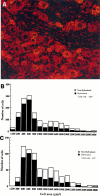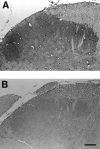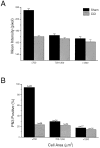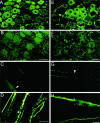Distribution of the tetrodotoxin-resistant sodium channel PN3 in rat sensory neurons in normal and neuropathic conditions
- PMID: 9482802
- PMCID: PMC6792911
- DOI: 10.1523/JNEUROSCI.18-06-02174.1998
Distribution of the tetrodotoxin-resistant sodium channel PN3 in rat sensory neurons in normal and neuropathic conditions
Abstract
The novel sodium channel PN3/alpha-SNS, which was cloned from a rat dorsal root ganglion (DRG) cDNA library, is expressed predominantly in small sensory neurons and may contribute to the tetrodotoxin-resistant (TTXR) sodium current that is believed to be associated with central sensitization in chronic neuropathic pain states. To assess further the role of PN3, we have used electrophysiological, in situ hybridization and immunohistochemical methods to monitor changes in TTXR sodium current and the distribution of PN3 in normal and peripheral nerve-injured rats. (1) Whole-cell patch-clamp recordings showed that there were no significant changes in the TTXR and TTX-sensitive sodium current densities of small DRG neurons after chronic constriction injury (CCI) of the sciatic nerve. (2) Additionally, in situ hybridization showed that there was no change in the expression of PN3 mRNA in the DRG up to 14 d after CCI. PN3 mRNA was not detected in sections of brain and spinal cord taken from either normal or nerve-injured rats. (3) In contrast, immunohistochemical studies showed that major changes in the subcellular distribution of PN3 protein were caused by either CCI or complete transection of the sciatic nerve. The intensity of PN3 immunolabeling decreased in small DRG neurons and increased in sciatic nerve axons at the site of injury. The alteration in immunolabeling was attributed to translocation of presynthesized, intracellularly located PN3 protein from neuronal somata to peripheral axons, with subsequent accumulation at the site of injury. The specific subcellular redistribution of PN3 after peripheral nerve injury may be an important factor in establishing peripheral nerve hyperexcitability and resultant neuropathic pain.
Figures











Similar articles
-
Differential role of GDNF and NGF in the maintenance of two TTX-resistant sodium channels in adult DRG neurons.Brain Res Mol Brain Res. 1999 Apr 20;67(2):267-82. doi: 10.1016/s0169-328x(99)00070-4. Brain Res Mol Brain Res. 1999. PMID: 10216225
-
Changes in expression of two tetrodotoxin-resistant sodium channels and their currents in dorsal root ganglion neurons after sciatic nerve injury but not rhizotomy.J Neurosci. 2000 Oct 1;20(19):7279-89. doi: 10.1523/JNEUROSCI.20-19-07279.2000. J Neurosci. 2000. PMID: 11007885 Free PMC article.
-
Rescue of alpha-SNS sodium channel expression in small dorsal root ganglion neurons after axotomy by nerve growth factor in vivo.J Neurophysiol. 1998 May;79(5):2668-76. doi: 10.1152/jn.1998.79.5.2668. J Neurophysiol. 1998. PMID: 9582237
-
A comparison of the potential role of the tetrodotoxin-insensitive sodium channels, PN3/SNS and NaN/SNS2, in rat models of chronic pain.Proc Natl Acad Sci U S A. 1999 Jul 6;96(14):7640-4. doi: 10.1073/pnas.96.14.7640. Proc Natl Acad Sci U S A. 1999. PMID: 10393873 Free PMC article. Review.
-
Sodium channels, excitability of primary sensory neurons, and the molecular basis of pain.Muscle Nerve. 1999 Sep;22(9):1177-87. doi: 10.1002/(sici)1097-4598(199909)22:9<1177::aid-mus3>3.0.co;2-p. Muscle Nerve. 1999. PMID: 10454712 Review.
Cited by
-
A review of dorsal root ganglia and primary sensory neuron plasticity mediating inflammatory and chronic neuropathic pain.Neurobiol Pain. 2024 Jan 20;15:100151. doi: 10.1016/j.ynpai.2024.100151. eCollection 2024 Jan-Jun. Neurobiol Pain. 2024. PMID: 38314104 Free PMC article. Review.
-
Voltage-gated Na(+) channels in chemoreceptor afferent neurons--potential roles and changes with development.Respir Physiol Neurobiol. 2013 Jan 1;185(1):67-74. doi: 10.1016/j.resp.2012.08.009. Epub 2012 Aug 18. Respir Physiol Neurobiol. 2013. PMID: 22906578 Free PMC article. Review.
-
Distinct degree of radiculopathy at different levels of peripheral nerve injury.Mol Pain. 2012 Apr 26;8:31. doi: 10.1186/1744-8069-8-31. Mol Pain. 2012. PMID: 22537715 Free PMC article.
-
Inactivation properties of sodium channel Nav1.8 maintain action potential amplitude in small DRG neurons in the context of depolarization.Mol Pain. 2007 May 31;3:12. doi: 10.1186/1744-8069-3-12. Mol Pain. 2007. PMID: 17540018 Free PMC article.
-
Alteration of primary afferent activity following inferior alveolar nerve transection in rats.Mol Pain. 2010 Feb 3;6:9. doi: 10.1186/1744-8069-6-9. Mol Pain. 2010. PMID: 20122287 Free PMC article.
References
-
- Akopian AN, Sivilotti L, Wood JN. A tetrodotoxin-resistant voltage-gated sodium channel expressed by sensory neurons. Nature. 1996;379:257–262. - PubMed
-
- Arbuckle JB, Docherty RJ. Expression of tetrodotoxin-resistant sodium channels in capsaicin-sensitive dorsal root ganglion neurons of adult rats. Neurosci Lett. 1995;185:70–73. - PubMed
-
- Attal N, Jazat F, Kayser V, Guilbaud G. Further evidence for pain-related behaviours in a model of unilateral peripheral mononeuropathy. Pain. 1990;41:235–251. - PubMed
-
- Basbaum AI, Gautron M, Jazat F, Mayes M, Guilbaud G. The spectrum of fiber loss in a model of neuropathic pain in the rat: an electron microscopic study. Pain. 1991;47:359–367. - PubMed
-
- Bennett GJ, Xie YK. A peripheral mononeuropathy in rat that produces disorders of pain sensation like those seen in man. Pain. 1988;33:87–107. - PubMed
Publication types
MeSH terms
Substances
LinkOut - more resources
Full Text Sources
Other Literature Sources
Medical
Molecular Biology Databases
